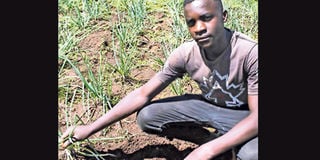Agronomist notebook: Taking care of onions during rainy season

Julius Mokua on his onion farm in Elburgon. One of the worst hit farmers by the ongoing heavy rains are those growing onions. PHOTO | JOHN NJOROGE | NMG
What you need to know:
- The high infestation was partly caused by improper spacing of the crop during planting. This led to overcrowded plants causing the disease to spread faster.
- The disease normally damages the leaves and bulbs, resulting in reduced yields. Often, the bulb ends up with a spongy texture.
- Other diseases that affect onions during rainy seasons include purple blotch caused by the fungus Alternaria porri, which first manifests as small, water-soaked lesions.
- To control the disease, remove affected leaves and onions as the pathogen can remain viable in the soil, awaiting the next crop.
The ongoing heavy rains across the country are causing many farmers agony. However, one of the worst hit farmers are those growing onions.
I recently visited an onion farmer, Ngatia, in Nyandarua County and realised first-hand the challenges onion growers are experiencing this rainy season. Ngatia’s crop had been affected by downy mildew, thanks to the rains.
The high infestation was partly caused by improper spacing of the crop during planting. This led to overcrowded plants causing the disease to spread faster.
The disease caused onion leaves to dry, making the plant to look like it is ripe for harvest. Most plants looked like they were fully mature, and yet the bulbs were too tiny. The withering leaves had irregular, yellow spots as others dried from the tips downwards.
Downey mildew is a fungal disease that infests the leaves and later the bulbs. It’s most common during the rainy season or in humid conditions.
The disease normally damages the leaves and bulbs, resulting in reduced yields. Often, the bulb ends up with a spongy texture.
In moist conditions, a white and later purplish mould grows on the leaf. During heavy infestation, the leaves usually have darker mould.
Since the disease spreads faster on farms where the crops are overcrowded, it is important to observe a spacing of 8cm inter-row and 10cm intercrop during planting.
Ensure your farm has good drainage to avoid damp conditions on the beds. This must be taken into consideration during the initial land preparation by raising the beds. Create drainage channels to reduce chances of water stagnating on the farm.
In areas where irrigation is practised, avoid overhead watering when the conditions are humid as this increases leaf wetness, hence, disease infestation. Timely weeding is ideal, as this allows free air circulation.
DRY FASTER
Affected bulbs should be removed and properly disposed of as the fungus remains in the soil for long periods. Usually, planting certified seeds that are resistant to downy mildew helps in minimising the occurrence of the disease.
In the nursery, follow the best management practices to end up with healthy seedlings that will give you a head start. To fully eradicate downy mildew, spraying with fungicide is recommended. Also do crop rotation as this helps to break the life cycle of the disease, reducing infestations.
Other diseases that affect onions during rainy seasons include purple blotch caused by the fungus Alternaria porri, which first manifests as small, water-soaked lesions.
The disease begins on the older leaves as small, sunken, water-soaked lesions with light centres. The lesions enlarge and progressively turn purple. The disease leads to smaller bulbs, which often rot quickly during the storage.
Purple blotch normally defoliates the onion crop prematurely and compromises the bulb quality, resulting into storage rot caused by secondary infections.
To control the disease, remove affected leaves and onions as the pathogen can remain viable in the soil, awaiting the next crop.
Also, as in the case with downy mildew, start with diseases-free seedlings and avoid excess nitrogen application.
Field hygiene should also be observed, including the removal of volunteer crops.
To avoid causing injuries to the neck, harvest onions during the dry season. In that case, allow all the onion leaves to dry up thoroughly before harvesting.
The rains have also affected the curing of onions, making them to sprout after harvesting. If the onions are ready, harvest them because leaving them on the farm makes them absorb more water decreasing the shelf-life.
Before harvesting, the farmer should neck the bulb onions for two days, uproot and store them in a dryer or under a shed. Necking is done by twisting the leaves and cutting them off, which happens when the plant is still vegetative.
Once the bulbs have been harvested, the farmer should keep on spreading them evenly to allow proper air circulation, which helps them to dry faster.





